Linguistics Proposal: Analyzing Les Brown's Motivational Speech
VerifiedAdded on 2023/01/11
|10
|3539
|48
Project
AI Summary
This linguistics proposal outlines a Critical Discourse Analysis (CDA) of Les Brown's motivational speech, employing Fairclough's 3D model. The proposal begins with an introduction detailing the significance of the study, research objectives, and research questions. It then proceeds to a comprehensive review of literature, exploring the conceptual background of CDA and relevant previous studies. The methodology section describes the data collection and analysis methods to be used. The proposal aims to analyze how language is used to convey meaning and influence the audience, focusing on the dimensions of text, discursive practice, and social practice within Brown's speech. The expected results will provide insights into how motivational messages are constructed and received, contributing to a better understanding of effective communication. This proposal seeks to understand how Brown uses language to inspire and motivate his audience, offering valuable insights for anyone interested in rhetoric, linguistics, and communication studies.
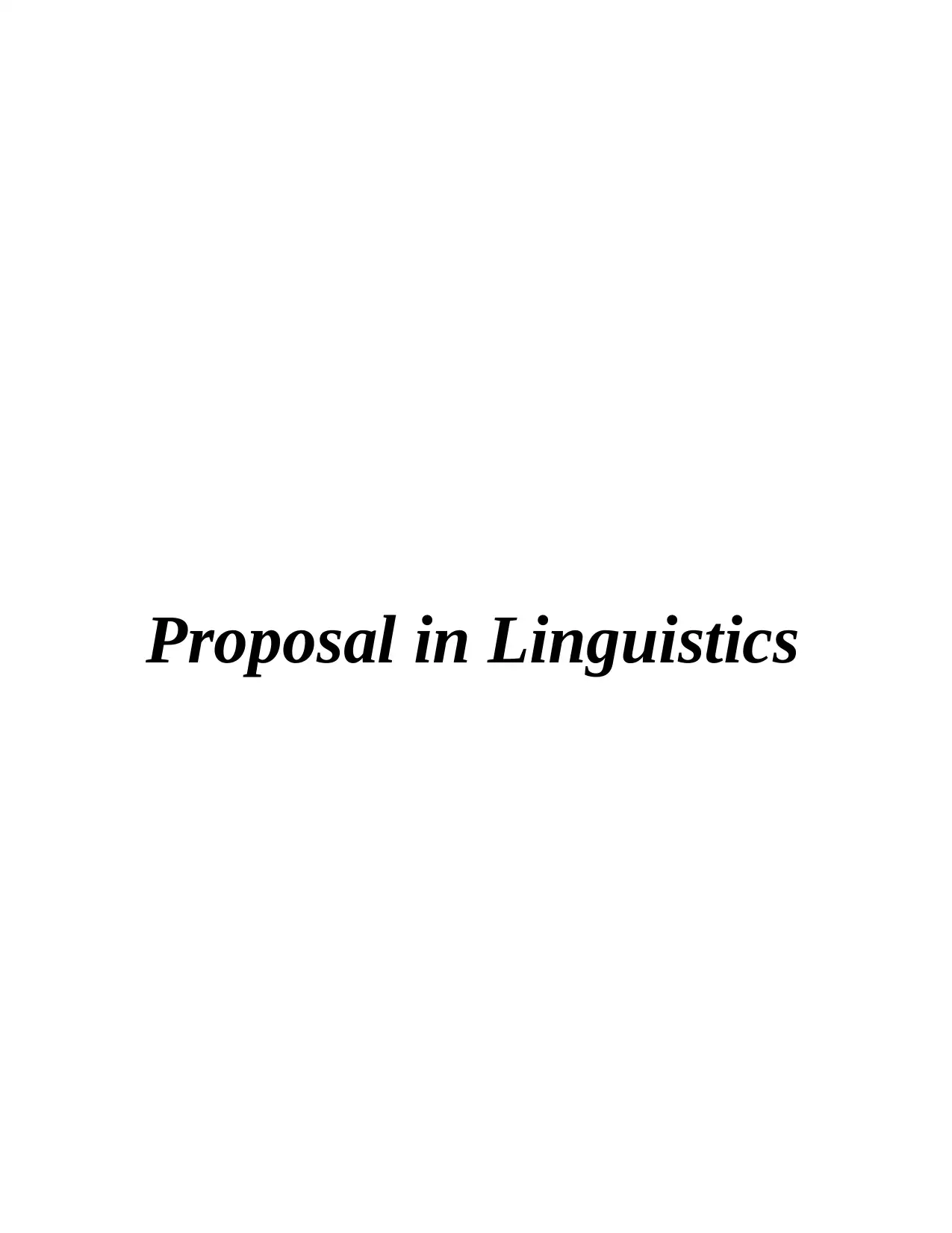
Proposal in Linguistics
Secure Best Marks with AI Grader
Need help grading? Try our AI Grader for instant feedback on your assignments.
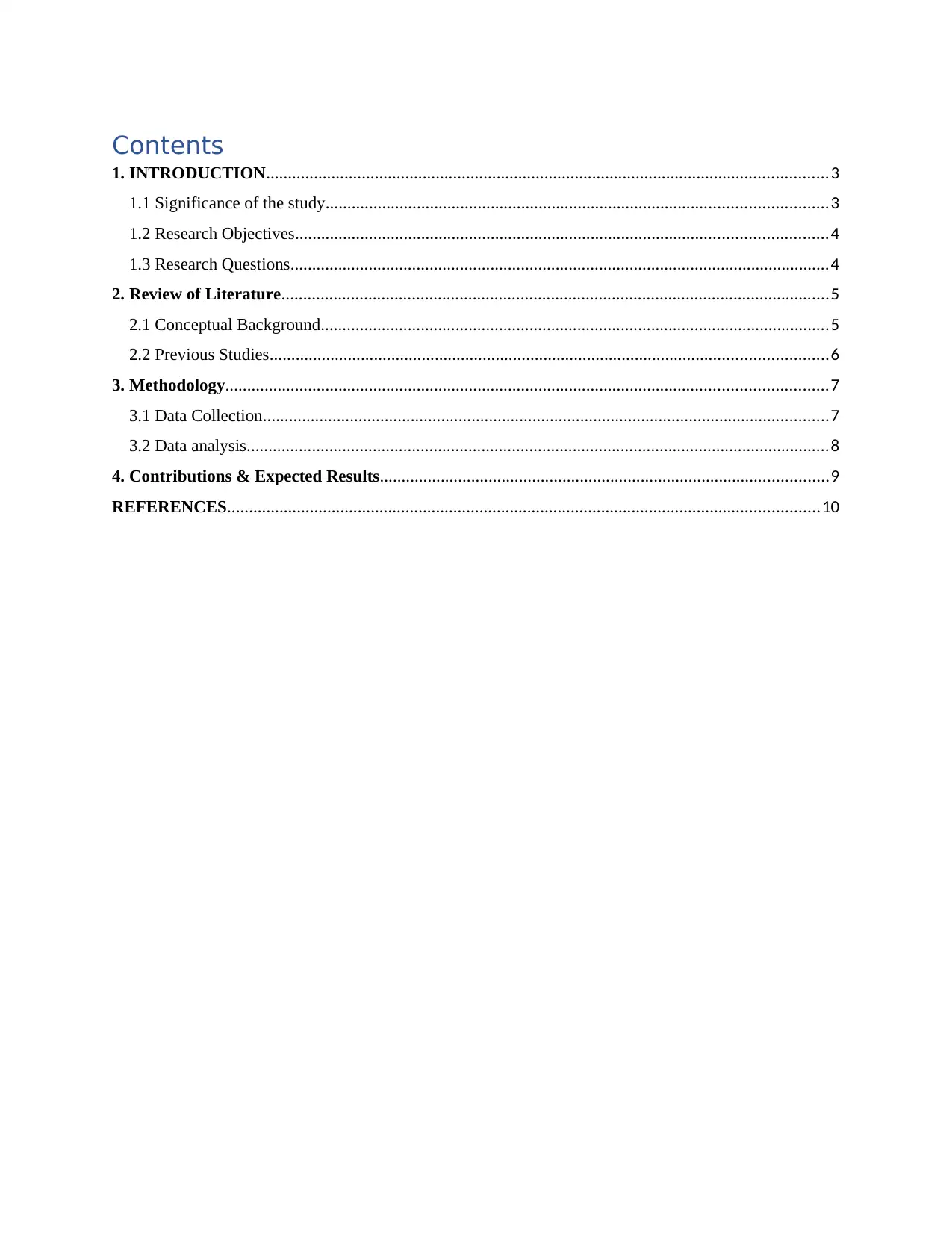
Contents
1. INTRODUCTION.................................................................................................................................3
1.1 Significance of the study...................................................................................................................3
1.2 Research Objectives..........................................................................................................................4
1.3 Research Questions............................................................................................................................4
2. Review of Literature..............................................................................................................................5
2.1 Conceptual Background.....................................................................................................................5
2.2 Previous Studies................................................................................................................................6
3. Methodology..........................................................................................................................................7
3.1 Data Collection..................................................................................................................................7
3.2 Data analysis......................................................................................................................................8
4. Contributions & Expected Results.......................................................................................................9
REFERENCES........................................................................................................................................10
1. INTRODUCTION.................................................................................................................................3
1.1 Significance of the study...................................................................................................................3
1.2 Research Objectives..........................................................................................................................4
1.3 Research Questions............................................................................................................................4
2. Review of Literature..............................................................................................................................5
2.1 Conceptual Background.....................................................................................................................5
2.2 Previous Studies................................................................................................................................6
3. Methodology..........................................................................................................................................7
3.1 Data Collection..................................................................................................................................7
3.2 Data analysis......................................................................................................................................8
4. Contributions & Expected Results.......................................................................................................9
REFERENCES........................................................................................................................................10
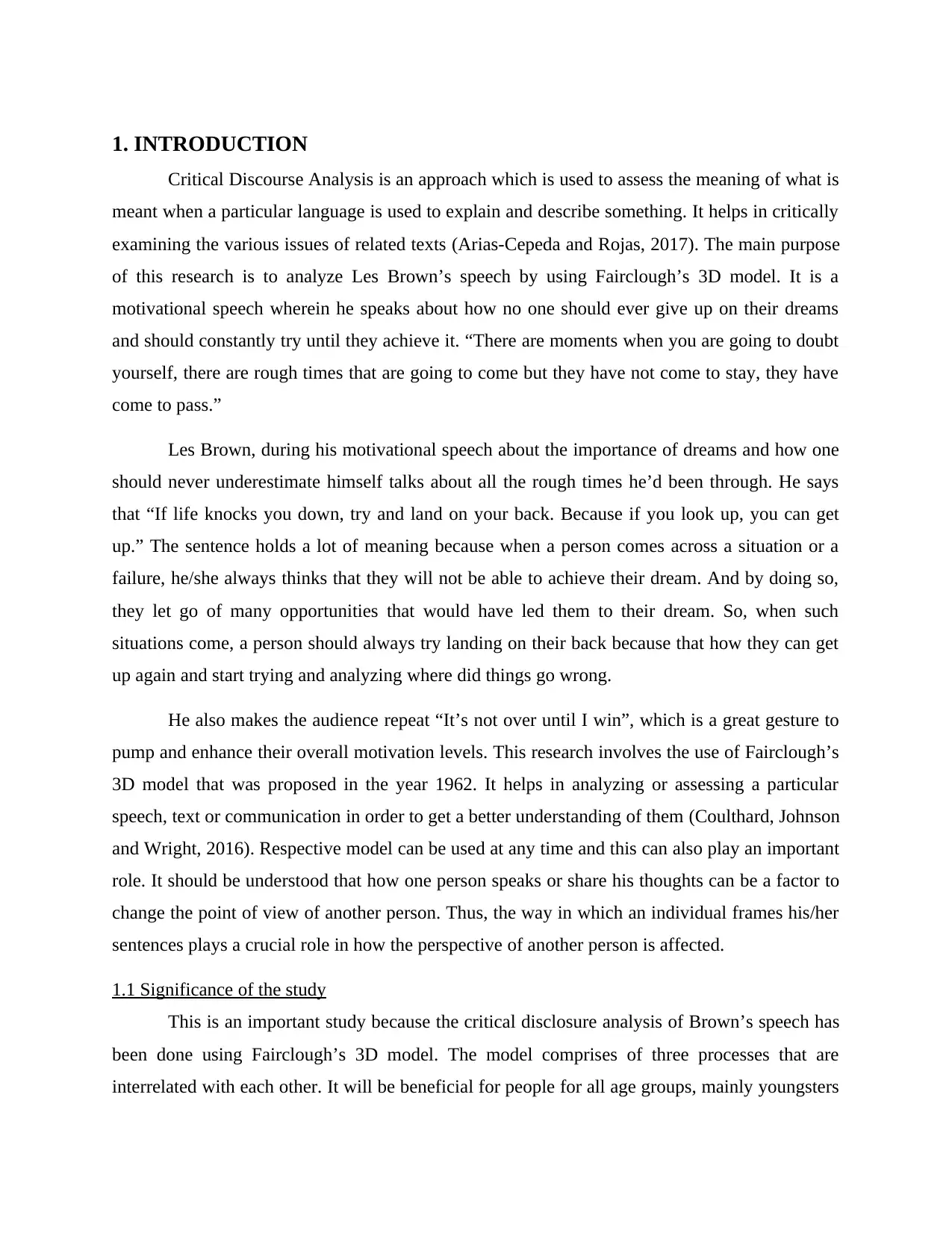
1. INTRODUCTION
Critical Discourse Analysis is an approach which is used to assess the meaning of what is
meant when a particular language is used to explain and describe something. It helps in critically
examining the various issues of related texts (Arias-Cepeda and Rojas, 2017). The main purpose
of this research is to analyze Les Brown’s speech by using Fairclough’s 3D model. It is a
motivational speech wherein he speaks about how no one should ever give up on their dreams
and should constantly try until they achieve it. “There are moments when you are going to doubt
yourself, there are rough times that are going to come but they have not come to stay, they have
come to pass.”
Les Brown, during his motivational speech about the importance of dreams and how one
should never underestimate himself talks about all the rough times he’d been through. He says
that “If life knocks you down, try and land on your back. Because if you look up, you can get
up.” The sentence holds a lot of meaning because when a person comes across a situation or a
failure, he/she always thinks that they will not be able to achieve their dream. And by doing so,
they let go of many opportunities that would have led them to their dream. So, when such
situations come, a person should always try landing on their back because that how they can get
up again and start trying and analyzing where did things go wrong.
He also makes the audience repeat “It’s not over until I win”, which is a great gesture to
pump and enhance their overall motivation levels. This research involves the use of Fairclough’s
3D model that was proposed in the year 1962. It helps in analyzing or assessing a particular
speech, text or communication in order to get a better understanding of them (Coulthard, Johnson
and Wright, 2016). Respective model can be used at any time and this can also play an important
role. It should be understood that how one person speaks or share his thoughts can be a factor to
change the point of view of another person. Thus, the way in which an individual frames his/her
sentences plays a crucial role in how the perspective of another person is affected.
1.1 Significance of the study
This is an important study because the critical disclosure analysis of Brown’s speech has
been done using Fairclough’s 3D model. The model comprises of three processes that are
interrelated with each other. It will be beneficial for people for all age groups, mainly youngsters
Critical Discourse Analysis is an approach which is used to assess the meaning of what is
meant when a particular language is used to explain and describe something. It helps in critically
examining the various issues of related texts (Arias-Cepeda and Rojas, 2017). The main purpose
of this research is to analyze Les Brown’s speech by using Fairclough’s 3D model. It is a
motivational speech wherein he speaks about how no one should ever give up on their dreams
and should constantly try until they achieve it. “There are moments when you are going to doubt
yourself, there are rough times that are going to come but they have not come to stay, they have
come to pass.”
Les Brown, during his motivational speech about the importance of dreams and how one
should never underestimate himself talks about all the rough times he’d been through. He says
that “If life knocks you down, try and land on your back. Because if you look up, you can get
up.” The sentence holds a lot of meaning because when a person comes across a situation or a
failure, he/she always thinks that they will not be able to achieve their dream. And by doing so,
they let go of many opportunities that would have led them to their dream. So, when such
situations come, a person should always try landing on their back because that how they can get
up again and start trying and analyzing where did things go wrong.
He also makes the audience repeat “It’s not over until I win”, which is a great gesture to
pump and enhance their overall motivation levels. This research involves the use of Fairclough’s
3D model that was proposed in the year 1962. It helps in analyzing or assessing a particular
speech, text or communication in order to get a better understanding of them (Coulthard, Johnson
and Wright, 2016). Respective model can be used at any time and this can also play an important
role. It should be understood that how one person speaks or share his thoughts can be a factor to
change the point of view of another person. Thus, the way in which an individual frames his/her
sentences plays a crucial role in how the perspective of another person is affected.
1.1 Significance of the study
This is an important study because the critical disclosure analysis of Brown’s speech has
been done using Fairclough’s 3D model. The model comprises of three processes that are
interrelated with each other. It will be beneficial for people for all age groups, mainly youngsters
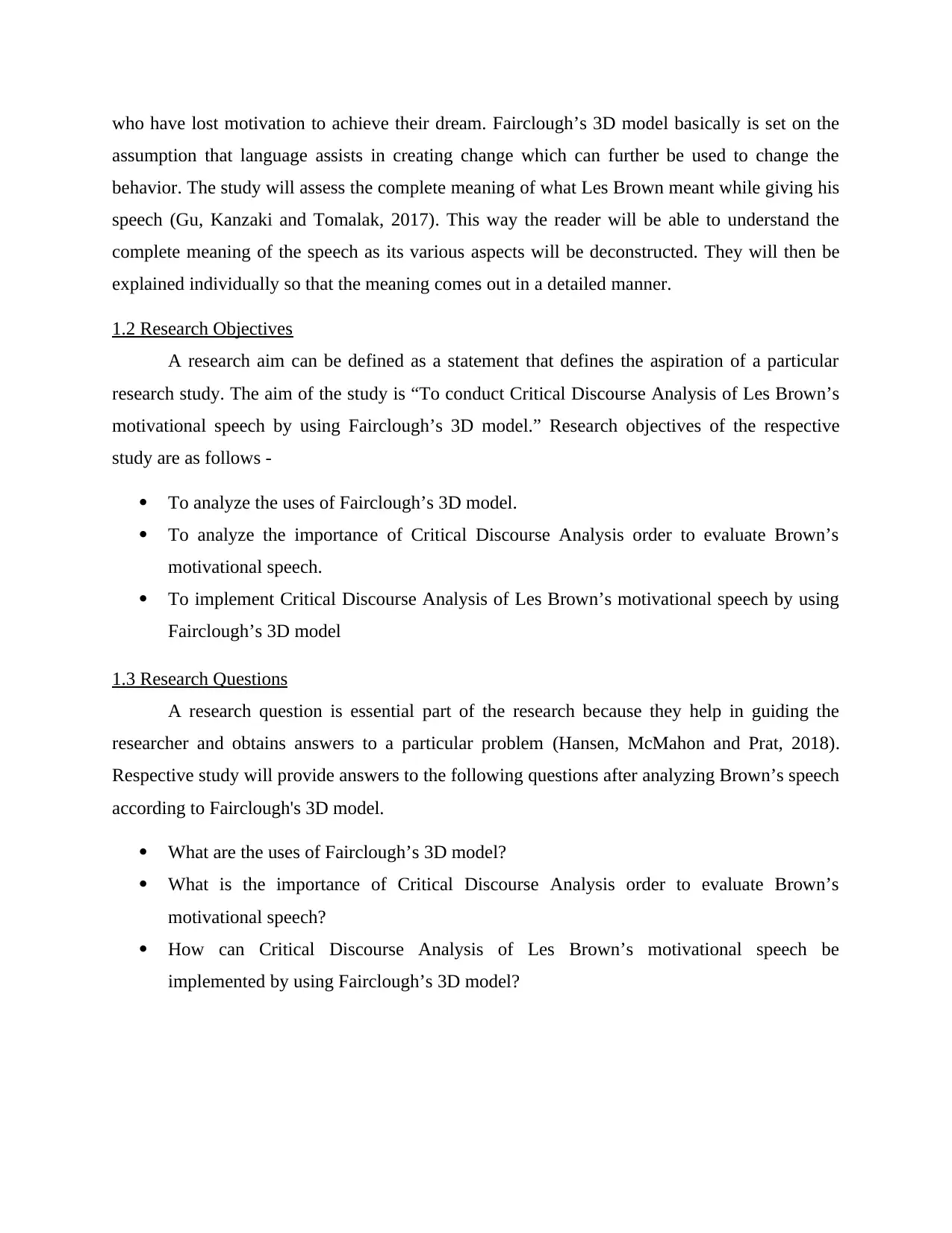
who have lost motivation to achieve their dream. Fairclough’s 3D model basically is set on the
assumption that language assists in creating change which can further be used to change the
behavior. The study will assess the complete meaning of what Les Brown meant while giving his
speech (Gu, Kanzaki and Tomalak, 2017). This way the reader will be able to understand the
complete meaning of the speech as its various aspects will be deconstructed. They will then be
explained individually so that the meaning comes out in a detailed manner.
1.2 Research Objectives
A research aim can be defined as a statement that defines the aspiration of a particular
research study. The aim of the study is “To conduct Critical Discourse Analysis of Les Brown’s
motivational speech by using Fairclough’s 3D model.” Research objectives of the respective
study are as follows -
To analyze the uses of Fairclough’s 3D model.
To analyze the importance of Critical Discourse Analysis order to evaluate Brown’s
motivational speech.
To implement Critical Discourse Analysis of Les Brown’s motivational speech by using
Fairclough’s 3D model
1.3 Research Questions
A research question is essential part of the research because they help in guiding the
researcher and obtains answers to a particular problem (Hansen, McMahon and Prat, 2018).
Respective study will provide answers to the following questions after analyzing Brown’s speech
according to Fairclough's 3D model.
What are the uses of Fairclough’s 3D model?
What is the importance of Critical Discourse Analysis order to evaluate Brown’s
motivational speech?
How can Critical Discourse Analysis of Les Brown’s motivational speech be
implemented by using Fairclough’s 3D model?
assumption that language assists in creating change which can further be used to change the
behavior. The study will assess the complete meaning of what Les Brown meant while giving his
speech (Gu, Kanzaki and Tomalak, 2017). This way the reader will be able to understand the
complete meaning of the speech as its various aspects will be deconstructed. They will then be
explained individually so that the meaning comes out in a detailed manner.
1.2 Research Objectives
A research aim can be defined as a statement that defines the aspiration of a particular
research study. The aim of the study is “To conduct Critical Discourse Analysis of Les Brown’s
motivational speech by using Fairclough’s 3D model.” Research objectives of the respective
study are as follows -
To analyze the uses of Fairclough’s 3D model.
To analyze the importance of Critical Discourse Analysis order to evaluate Brown’s
motivational speech.
To implement Critical Discourse Analysis of Les Brown’s motivational speech by using
Fairclough’s 3D model
1.3 Research Questions
A research question is essential part of the research because they help in guiding the
researcher and obtains answers to a particular problem (Hansen, McMahon and Prat, 2018).
Respective study will provide answers to the following questions after analyzing Brown’s speech
according to Fairclough's 3D model.
What are the uses of Fairclough’s 3D model?
What is the importance of Critical Discourse Analysis order to evaluate Brown’s
motivational speech?
How can Critical Discourse Analysis of Les Brown’s motivational speech be
implemented by using Fairclough’s 3D model?
Secure Best Marks with AI Grader
Need help grading? Try our AI Grader for instant feedback on your assignments.
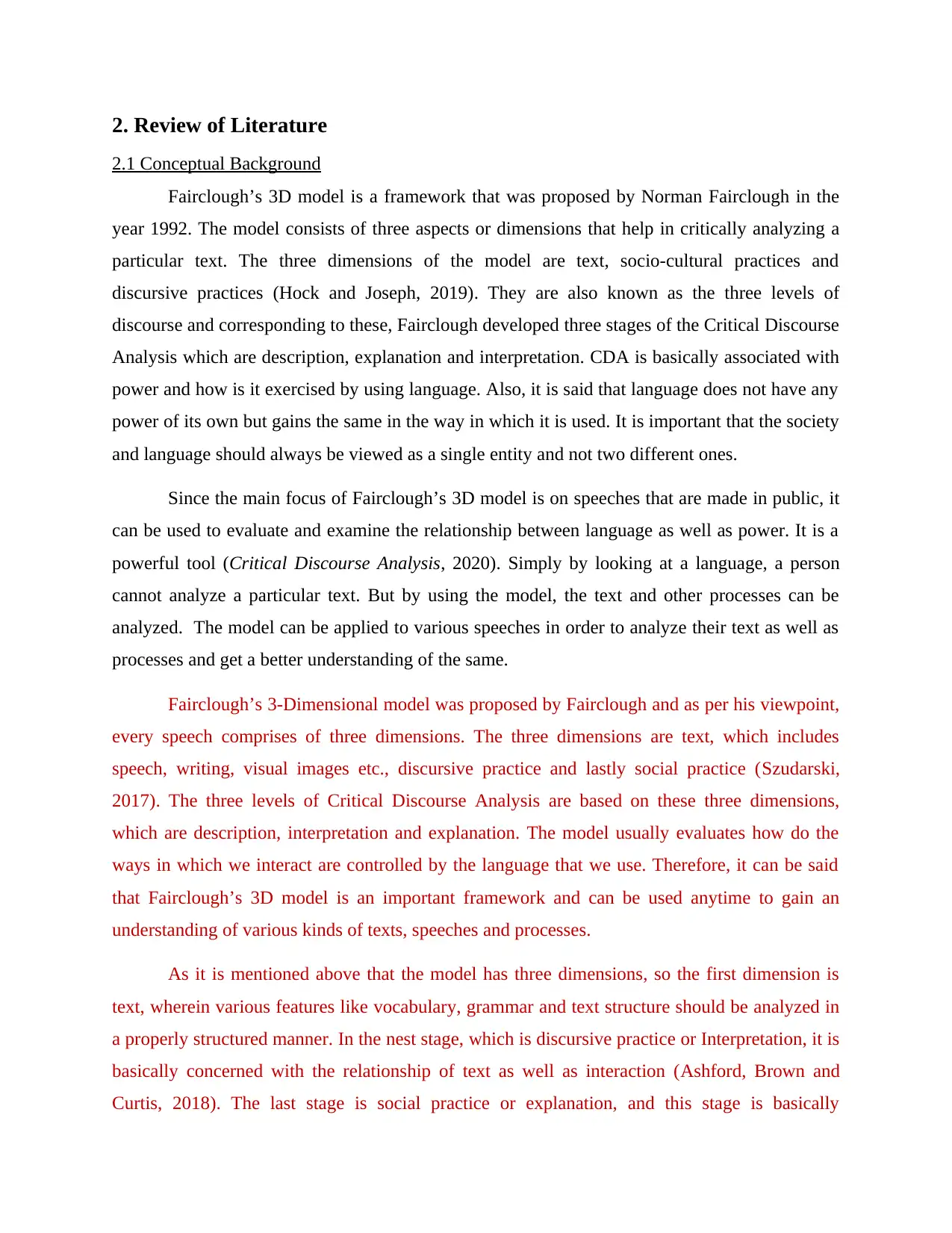
2. Review of Literature
2.1 Conceptual Background
Fairclough’s 3D model is a framework that was proposed by Norman Fairclough in the
year 1992. The model consists of three aspects or dimensions that help in critically analyzing a
particular text. The three dimensions of the model are text, socio-cultural practices and
discursive practices (Hock and Joseph, 2019). They are also known as the three levels of
discourse and corresponding to these, Fairclough developed three stages of the Critical Discourse
Analysis which are description, explanation and interpretation. CDA is basically associated with
power and how is it exercised by using language. Also, it is said that language does not have any
power of its own but gains the same in the way in which it is used. It is important that the society
and language should always be viewed as a single entity and not two different ones.
Since the main focus of Fairclough’s 3D model is on speeches that are made in public, it
can be used to evaluate and examine the relationship between language as well as power. It is a
powerful tool (Critical Discourse Analysis, 2020). Simply by looking at a language, a person
cannot analyze a particular text. But by using the model, the text and other processes can be
analyzed. The model can be applied to various speeches in order to analyze their text as well as
processes and get a better understanding of the same.
Fairclough’s 3-Dimensional model was proposed by Fairclough and as per his viewpoint,
every speech comprises of three dimensions. The three dimensions are text, which includes
speech, writing, visual images etc., discursive practice and lastly social practice (Szudarski,
2017). The three levels of Critical Discourse Analysis are based on these three dimensions,
which are description, interpretation and explanation. The model usually evaluates how do the
ways in which we interact are controlled by the language that we use. Therefore, it can be said
that Fairclough’s 3D model is an important framework and can be used anytime to gain an
understanding of various kinds of texts, speeches and processes.
As it is mentioned above that the model has three dimensions, so the first dimension is
text, wherein various features like vocabulary, grammar and text structure should be analyzed in
a properly structured manner. In the nest stage, which is discursive practice or Interpretation, it is
basically concerned with the relationship of text as well as interaction (Ashford, Brown and
Curtis, 2018). The last stage is social practice or explanation, and this stage is basically
2.1 Conceptual Background
Fairclough’s 3D model is a framework that was proposed by Norman Fairclough in the
year 1992. The model consists of three aspects or dimensions that help in critically analyzing a
particular text. The three dimensions of the model are text, socio-cultural practices and
discursive practices (Hock and Joseph, 2019). They are also known as the three levels of
discourse and corresponding to these, Fairclough developed three stages of the Critical Discourse
Analysis which are description, explanation and interpretation. CDA is basically associated with
power and how is it exercised by using language. Also, it is said that language does not have any
power of its own but gains the same in the way in which it is used. It is important that the society
and language should always be viewed as a single entity and not two different ones.
Since the main focus of Fairclough’s 3D model is on speeches that are made in public, it
can be used to evaluate and examine the relationship between language as well as power. It is a
powerful tool (Critical Discourse Analysis, 2020). Simply by looking at a language, a person
cannot analyze a particular text. But by using the model, the text and other processes can be
analyzed. The model can be applied to various speeches in order to analyze their text as well as
processes and get a better understanding of the same.
Fairclough’s 3-Dimensional model was proposed by Fairclough and as per his viewpoint,
every speech comprises of three dimensions. The three dimensions are text, which includes
speech, writing, visual images etc., discursive practice and lastly social practice (Szudarski,
2017). The three levels of Critical Discourse Analysis are based on these three dimensions,
which are description, interpretation and explanation. The model usually evaluates how do the
ways in which we interact are controlled by the language that we use. Therefore, it can be said
that Fairclough’s 3D model is an important framework and can be used anytime to gain an
understanding of various kinds of texts, speeches and processes.
As it is mentioned above that the model has three dimensions, so the first dimension is
text, wherein various features like vocabulary, grammar and text structure should be analyzed in
a properly structured manner. In the nest stage, which is discursive practice or Interpretation, it is
basically concerned with the relationship of text as well as interaction (Ashford, Brown and
Curtis, 2018). The last stage is social practice or explanation, and this stage is basically
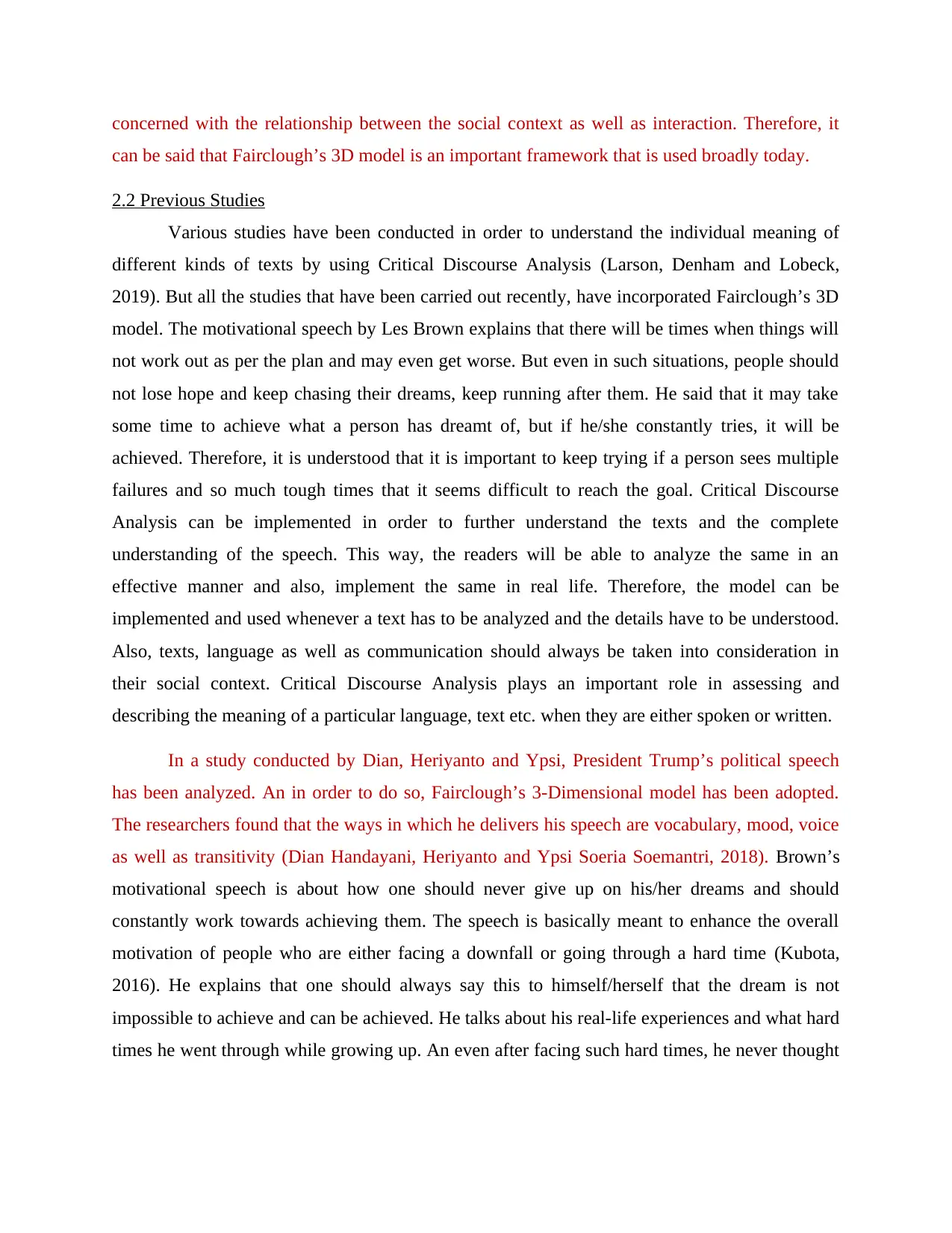
concerned with the relationship between the social context as well as interaction. Therefore, it
can be said that Fairclough’s 3D model is an important framework that is used broadly today.
2.2 Previous Studies
Various studies have been conducted in order to understand the individual meaning of
different kinds of texts by using Critical Discourse Analysis (Larson, Denham and Lobeck,
2019). But all the studies that have been carried out recently, have incorporated Fairclough’s 3D
model. The motivational speech by Les Brown explains that there will be times when things will
not work out as per the plan and may even get worse. But even in such situations, people should
not lose hope and keep chasing their dreams, keep running after them. He said that it may take
some time to achieve what a person has dreamt of, but if he/she constantly tries, it will be
achieved. Therefore, it is understood that it is important to keep trying if a person sees multiple
failures and so much tough times that it seems difficult to reach the goal. Critical Discourse
Analysis can be implemented in order to further understand the texts and the complete
understanding of the speech. This way, the readers will be able to analyze the same in an
effective manner and also, implement the same in real life. Therefore, the model can be
implemented and used whenever a text has to be analyzed and the details have to be understood.
Also, texts, language as well as communication should always be taken into consideration in
their social context. Critical Discourse Analysis plays an important role in assessing and
describing the meaning of a particular language, text etc. when they are either spoken or written.
In a study conducted by Dian, Heriyanto and Ypsi, President Trump’s political speech
has been analyzed. An in order to do so, Fairclough’s 3-Dimensional model has been adopted.
The researchers found that the ways in which he delivers his speech are vocabulary, mood, voice
as well as transitivity (Dian Handayani, Heriyanto and Ypsi Soeria Soemantri, 2018). Brown’s
motivational speech is about how one should never give up on his/her dreams and should
constantly work towards achieving them. The speech is basically meant to enhance the overall
motivation of people who are either facing a downfall or going through a hard time (Kubota,
2016). He explains that one should always say this to himself/herself that the dream is not
impossible to achieve and can be achieved. He talks about his real-life experiences and what hard
times he went through while growing up. An even after facing such hard times, he never thought
can be said that Fairclough’s 3D model is an important framework that is used broadly today.
2.2 Previous Studies
Various studies have been conducted in order to understand the individual meaning of
different kinds of texts by using Critical Discourse Analysis (Larson, Denham and Lobeck,
2019). But all the studies that have been carried out recently, have incorporated Fairclough’s 3D
model. The motivational speech by Les Brown explains that there will be times when things will
not work out as per the plan and may even get worse. But even in such situations, people should
not lose hope and keep chasing their dreams, keep running after them. He said that it may take
some time to achieve what a person has dreamt of, but if he/she constantly tries, it will be
achieved. Therefore, it is understood that it is important to keep trying if a person sees multiple
failures and so much tough times that it seems difficult to reach the goal. Critical Discourse
Analysis can be implemented in order to further understand the texts and the complete
understanding of the speech. This way, the readers will be able to analyze the same in an
effective manner and also, implement the same in real life. Therefore, the model can be
implemented and used whenever a text has to be analyzed and the details have to be understood.
Also, texts, language as well as communication should always be taken into consideration in
their social context. Critical Discourse Analysis plays an important role in assessing and
describing the meaning of a particular language, text etc. when they are either spoken or written.
In a study conducted by Dian, Heriyanto and Ypsi, President Trump’s political speech
has been analyzed. An in order to do so, Fairclough’s 3-Dimensional model has been adopted.
The researchers found that the ways in which he delivers his speech are vocabulary, mood, voice
as well as transitivity (Dian Handayani, Heriyanto and Ypsi Soeria Soemantri, 2018). Brown’s
motivational speech is about how one should never give up on his/her dreams and should
constantly work towards achieving them. The speech is basically meant to enhance the overall
motivation of people who are either facing a downfall or going through a hard time (Kubota,
2016). He explains that one should always say this to himself/herself that the dream is not
impossible to achieve and can be achieved. He talks about his real-life experiences and what hard
times he went through while growing up. An even after facing such hard times, he never thought
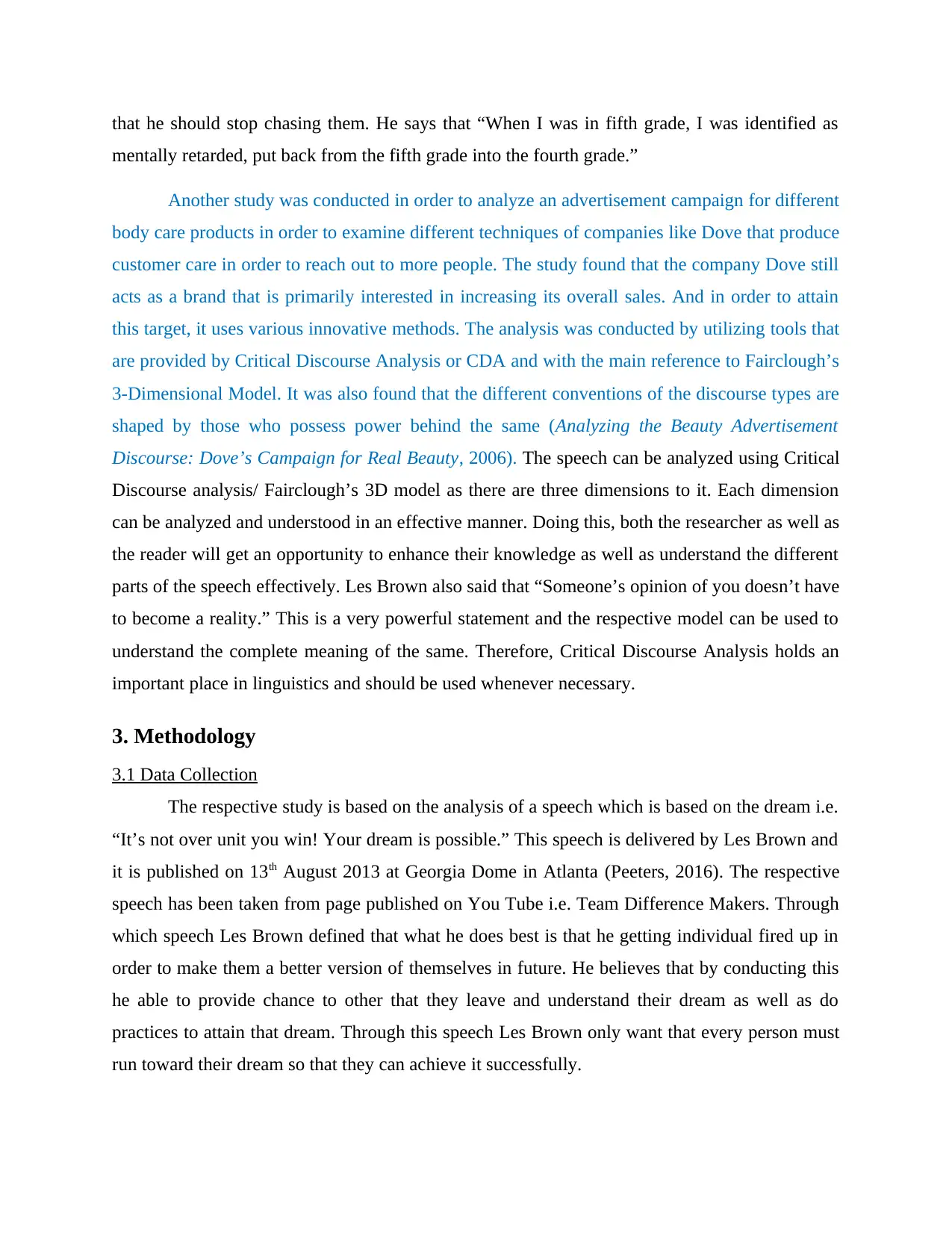
that he should stop chasing them. He says that “When I was in fifth grade, I was identified as
mentally retarded, put back from the fifth grade into the fourth grade.”
Another study was conducted in order to analyze an advertisement campaign for different
body care products in order to examine different techniques of companies like Dove that produce
customer care in order to reach out to more people. The study found that the company Dove still
acts as a brand that is primarily interested in increasing its overall sales. And in order to attain
this target, it uses various innovative methods. The analysis was conducted by utilizing tools that
are provided by Critical Discourse Analysis or CDA and with the main reference to Fairclough’s
3-Dimensional Model. It was also found that the different conventions of the discourse types are
shaped by those who possess power behind the same (Analyzing the Beauty Advertisement
Discourse: Dove’s Campaign for Real Beauty, 2006). The speech can be analyzed using Critical
Discourse analysis/ Fairclough’s 3D model as there are three dimensions to it. Each dimension
can be analyzed and understood in an effective manner. Doing this, both the researcher as well as
the reader will get an opportunity to enhance their knowledge as well as understand the different
parts of the speech effectively. Les Brown also said that “Someone’s opinion of you doesn’t have
to become a reality.” This is a very powerful statement and the respective model can be used to
understand the complete meaning of the same. Therefore, Critical Discourse Analysis holds an
important place in linguistics and should be used whenever necessary.
3. Methodology
3.1 Data Collection
The respective study is based on the analysis of a speech which is based on the dream i.e.
“It’s not over unit you win! Your dream is possible.” This speech is delivered by Les Brown and
it is published on 13th August 2013 at Georgia Dome in Atlanta (Peeters, 2016). The respective
speech has been taken from page published on You Tube i.e. Team Difference Makers. Through
which speech Les Brown defined that what he does best is that he getting individual fired up in
order to make them a better version of themselves in future. He believes that by conducting this
he able to provide chance to other that they leave and understand their dream as well as do
practices to attain that dream. Through this speech Les Brown only want that every person must
run toward their dream so that they can achieve it successfully.
mentally retarded, put back from the fifth grade into the fourth grade.”
Another study was conducted in order to analyze an advertisement campaign for different
body care products in order to examine different techniques of companies like Dove that produce
customer care in order to reach out to more people. The study found that the company Dove still
acts as a brand that is primarily interested in increasing its overall sales. And in order to attain
this target, it uses various innovative methods. The analysis was conducted by utilizing tools that
are provided by Critical Discourse Analysis or CDA and with the main reference to Fairclough’s
3-Dimensional Model. It was also found that the different conventions of the discourse types are
shaped by those who possess power behind the same (Analyzing the Beauty Advertisement
Discourse: Dove’s Campaign for Real Beauty, 2006). The speech can be analyzed using Critical
Discourse analysis/ Fairclough’s 3D model as there are three dimensions to it. Each dimension
can be analyzed and understood in an effective manner. Doing this, both the researcher as well as
the reader will get an opportunity to enhance their knowledge as well as understand the different
parts of the speech effectively. Les Brown also said that “Someone’s opinion of you doesn’t have
to become a reality.” This is a very powerful statement and the respective model can be used to
understand the complete meaning of the same. Therefore, Critical Discourse Analysis holds an
important place in linguistics and should be used whenever necessary.
3. Methodology
3.1 Data Collection
The respective study is based on the analysis of a speech which is based on the dream i.e.
“It’s not over unit you win! Your dream is possible.” This speech is delivered by Les Brown and
it is published on 13th August 2013 at Georgia Dome in Atlanta (Peeters, 2016). The respective
speech has been taken from page published on You Tube i.e. Team Difference Makers. Through
which speech Les Brown defined that what he does best is that he getting individual fired up in
order to make them a better version of themselves in future. He believes that by conducting this
he able to provide chance to other that they leave and understand their dream as well as do
practices to attain that dream. Through this speech Les Brown only want that every person must
run toward their dream so that they can achieve it successfully.
Paraphrase This Document
Need a fresh take? Get an instant paraphrase of this document with our AI Paraphraser
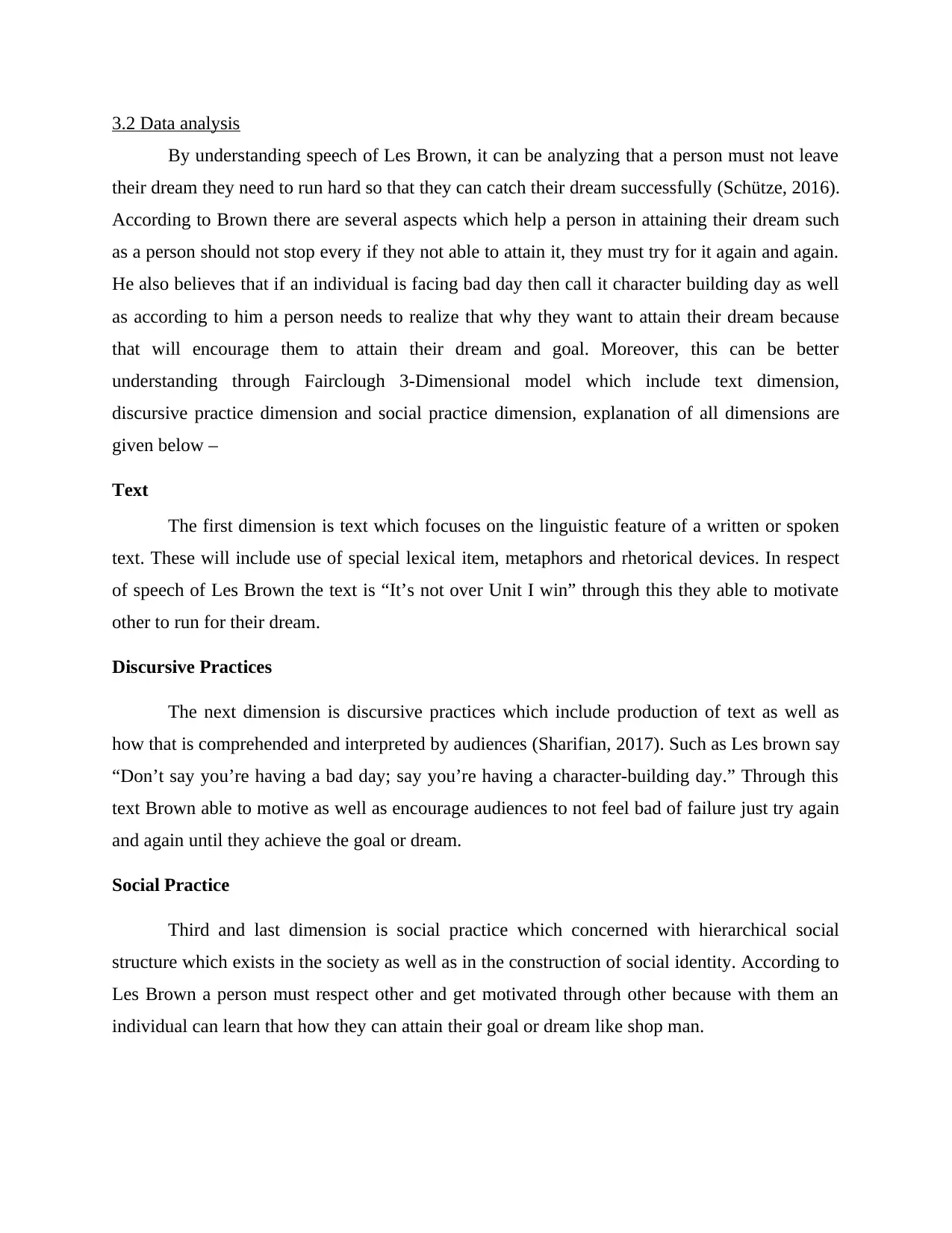
3.2 Data analysis
By understanding speech of Les Brown, it can be analyzing that a person must not leave
their dream they need to run hard so that they can catch their dream successfully (Schütze, 2016).
According to Brown there are several aspects which help a person in attaining their dream such
as a person should not stop every if they not able to attain it, they must try for it again and again.
He also believes that if an individual is facing bad day then call it character building day as well
as according to him a person needs to realize that why they want to attain their dream because
that will encourage them to attain their dream and goal. Moreover, this can be better
understanding through Fairclough 3-Dimensional model which include text dimension,
discursive practice dimension and social practice dimension, explanation of all dimensions are
given below –
Text
The first dimension is text which focuses on the linguistic feature of a written or spoken
text. These will include use of special lexical item, metaphors and rhetorical devices. In respect
of speech of Les Brown the text is “It’s not over Unit I win” through this they able to motivate
other to run for their dream.
Discursive Practices
The next dimension is discursive practices which include production of text as well as
how that is comprehended and interpreted by audiences (Sharifian, 2017). Such as Les brown say
“Don’t say you’re having a bad day; say you’re having a character-building day.” Through this
text Brown able to motive as well as encourage audiences to not feel bad of failure just try again
and again until they achieve the goal or dream.
Social Practice
Third and last dimension is social practice which concerned with hierarchical social
structure which exists in the society as well as in the construction of social identity. According to
Les Brown a person must respect other and get motivated through other because with them an
individual can learn that how they can attain their goal or dream like shop man.
By understanding speech of Les Brown, it can be analyzing that a person must not leave
their dream they need to run hard so that they can catch their dream successfully (Schütze, 2016).
According to Brown there are several aspects which help a person in attaining their dream such
as a person should not stop every if they not able to attain it, they must try for it again and again.
He also believes that if an individual is facing bad day then call it character building day as well
as according to him a person needs to realize that why they want to attain their dream because
that will encourage them to attain their dream and goal. Moreover, this can be better
understanding through Fairclough 3-Dimensional model which include text dimension,
discursive practice dimension and social practice dimension, explanation of all dimensions are
given below –
Text
The first dimension is text which focuses on the linguistic feature of a written or spoken
text. These will include use of special lexical item, metaphors and rhetorical devices. In respect
of speech of Les Brown the text is “It’s not over Unit I win” through this they able to motivate
other to run for their dream.
Discursive Practices
The next dimension is discursive practices which include production of text as well as
how that is comprehended and interpreted by audiences (Sharifian, 2017). Such as Les brown say
“Don’t say you’re having a bad day; say you’re having a character-building day.” Through this
text Brown able to motive as well as encourage audiences to not feel bad of failure just try again
and again until they achieve the goal or dream.
Social Practice
Third and last dimension is social practice which concerned with hierarchical social
structure which exists in the society as well as in the construction of social identity. According to
Les Brown a person must respect other and get motivated through other because with them an
individual can learn that how they can attain their goal or dream like shop man.
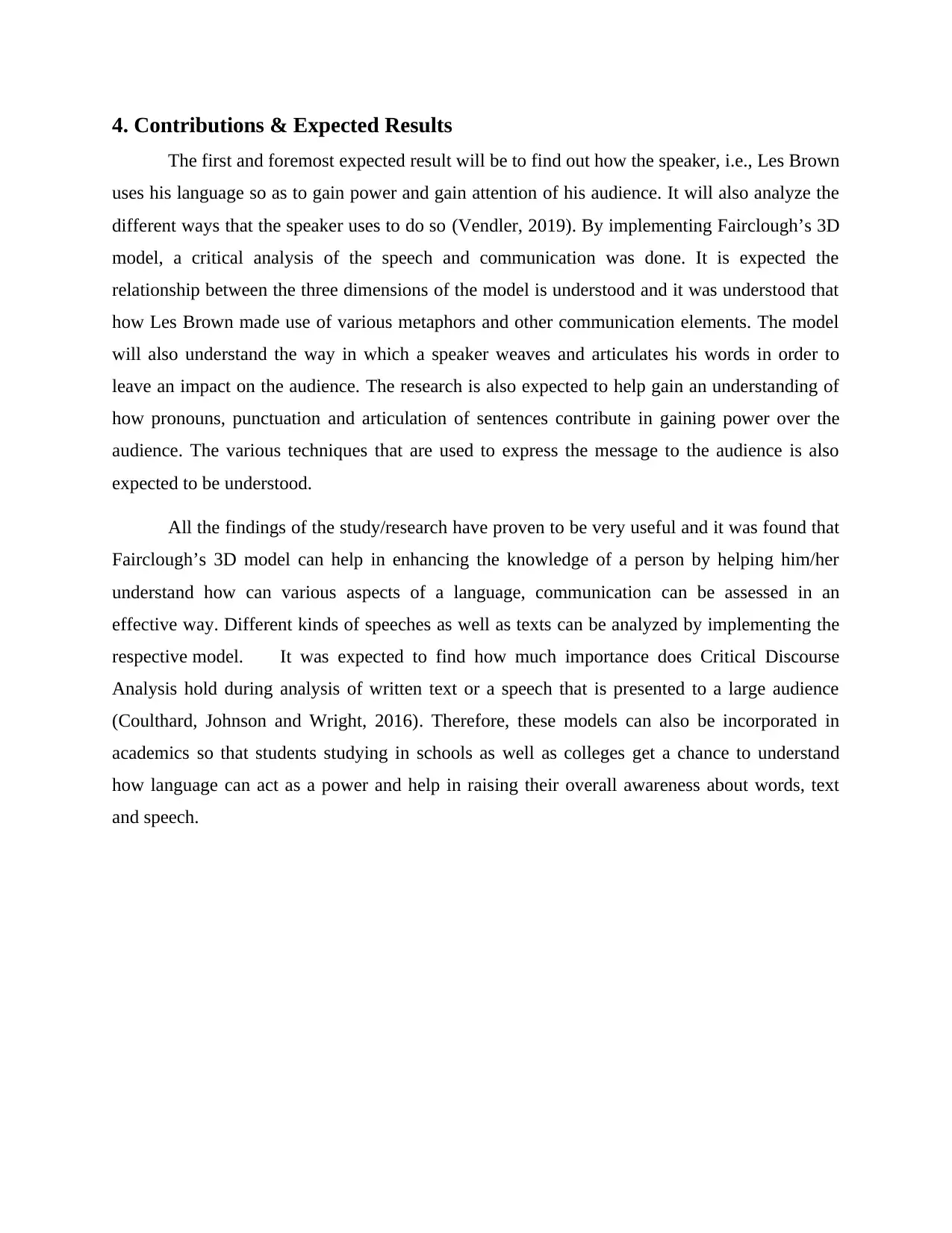
4. Contributions & Expected Results
The first and foremost expected result will be to find out how the speaker, i.e., Les Brown
uses his language so as to gain power and gain attention of his audience. It will also analyze the
different ways that the speaker uses to do so (Vendler, 2019). By implementing Fairclough’s 3D
model, a critical analysis of the speech and communication was done. It is expected the
relationship between the three dimensions of the model is understood and it was understood that
how Les Brown made use of various metaphors and other communication elements. The model
will also understand the way in which a speaker weaves and articulates his words in order to
leave an impact on the audience. The research is also expected to help gain an understanding of
how pronouns, punctuation and articulation of sentences contribute in gaining power over the
audience. The various techniques that are used to express the message to the audience is also
expected to be understood.
All the findings of the study/research have proven to be very useful and it was found that
Fairclough’s 3D model can help in enhancing the knowledge of a person by helping him/her
understand how can various aspects of a language, communication can be assessed in an
effective way. Different kinds of speeches as well as texts can be analyzed by implementing the
respective model. It was expected to find how much importance does Critical Discourse
Analysis hold during analysis of written text or a speech that is presented to a large audience
(Coulthard, Johnson and Wright, 2016). Therefore, these models can also be incorporated in
academics so that students studying in schools as well as colleges get a chance to understand
how language can act as a power and help in raising their overall awareness about words, text
and speech.
The first and foremost expected result will be to find out how the speaker, i.e., Les Brown
uses his language so as to gain power and gain attention of his audience. It will also analyze the
different ways that the speaker uses to do so (Vendler, 2019). By implementing Fairclough’s 3D
model, a critical analysis of the speech and communication was done. It is expected the
relationship between the three dimensions of the model is understood and it was understood that
how Les Brown made use of various metaphors and other communication elements. The model
will also understand the way in which a speaker weaves and articulates his words in order to
leave an impact on the audience. The research is also expected to help gain an understanding of
how pronouns, punctuation and articulation of sentences contribute in gaining power over the
audience. The various techniques that are used to express the message to the audience is also
expected to be understood.
All the findings of the study/research have proven to be very useful and it was found that
Fairclough’s 3D model can help in enhancing the knowledge of a person by helping him/her
understand how can various aspects of a language, communication can be assessed in an
effective way. Different kinds of speeches as well as texts can be analyzed by implementing the
respective model. It was expected to find how much importance does Critical Discourse
Analysis hold during analysis of written text or a speech that is presented to a large audience
(Coulthard, Johnson and Wright, 2016). Therefore, these models can also be incorporated in
academics so that students studying in schools as well as colleges get a chance to understand
how language can act as a power and help in raising their overall awareness about words, text
and speech.
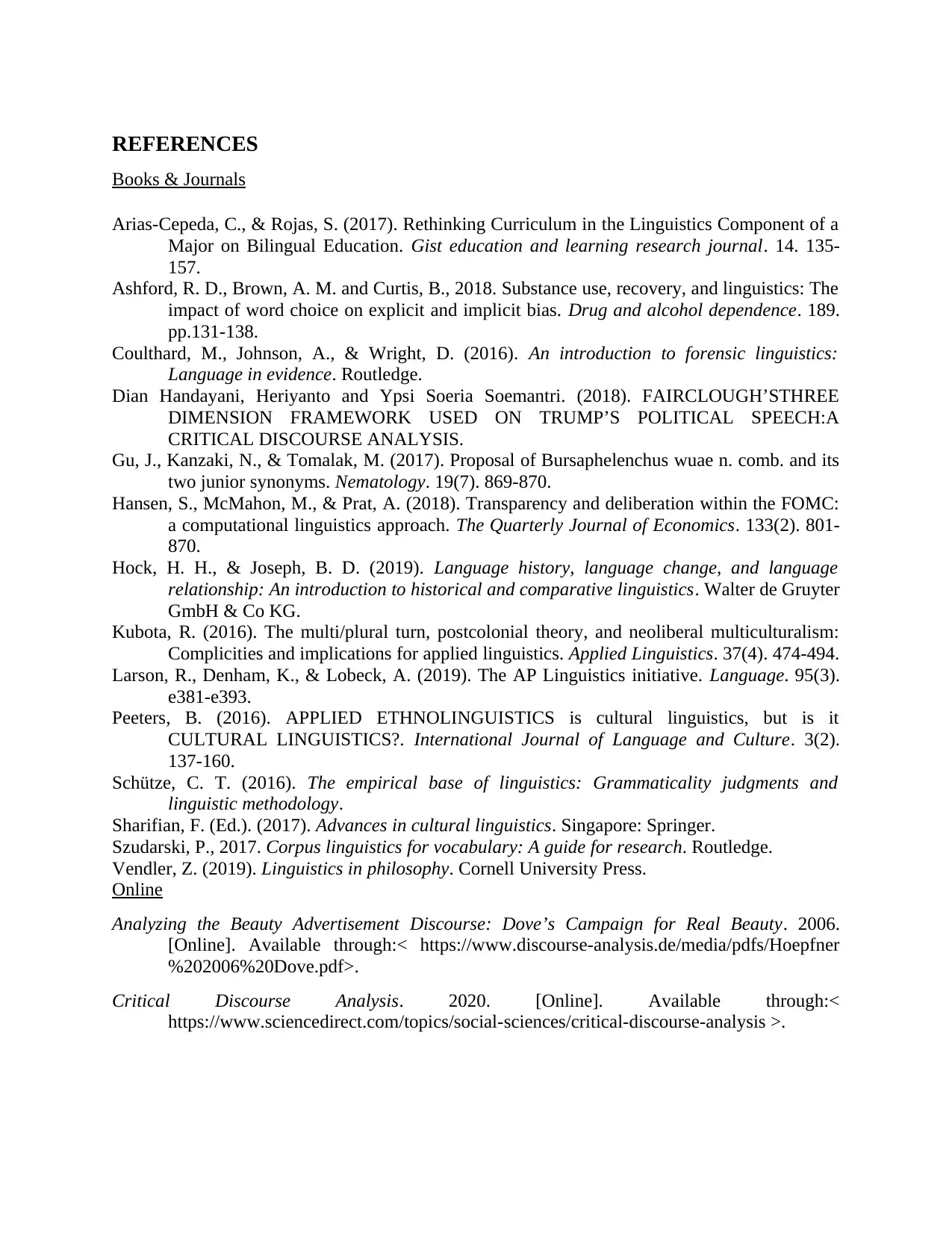
REFERENCES
Books & Journals
Arias-Cepeda, C., & Rojas, S. (2017). Rethinking Curriculum in the Linguistics Component of a
Major on Bilingual Education. Gist education and learning research journal. 14. 135-
157.
Ashford, R. D., Brown, A. M. and Curtis, B., 2018. Substance use, recovery, and linguistics: The
impact of word choice on explicit and implicit bias. Drug and alcohol dependence. 189.
pp.131-138.
Coulthard, M., Johnson, A., & Wright, D. (2016). An introduction to forensic linguistics:
Language in evidence. Routledge.
Dian Handayani, Heriyanto and Ypsi Soeria Soemantri. (2018). FAIRCLOUGH’STHREE
DIMENSION FRAMEWORK USED ON TRUMP’S POLITICAL SPEECH:A
CRITICAL DISCOURSE ANALYSIS.
Gu, J., Kanzaki, N., & Tomalak, M. (2017). Proposal of Bursaphelenchus wuae n. comb. and its
two junior synonyms. Nematology. 19(7). 869-870.
Hansen, S., McMahon, M., & Prat, A. (2018). Transparency and deliberation within the FOMC:
a computational linguistics approach. The Quarterly Journal of Economics. 133(2). 801-
870.
Hock, H. H., & Joseph, B. D. (2019). Language history, language change, and language
relationship: An introduction to historical and comparative linguistics. Walter de Gruyter
GmbH & Co KG.
Kubota, R. (2016). The multi/plural turn, postcolonial theory, and neoliberal multiculturalism:
Complicities and implications for applied linguistics. Applied Linguistics. 37(4). 474-494.
Larson, R., Denham, K., & Lobeck, A. (2019). The AP Linguistics initiative. Language. 95(3).
e381-e393.
Peeters, B. (2016). APPLIED ETHNOLINGUISTICS is cultural linguistics, but is it
CULTURAL LINGUISTICS?. International Journal of Language and Culture. 3(2).
137-160.
Schütze, C. T. (2016). The empirical base of linguistics: Grammaticality judgments and
linguistic methodology.
Sharifian, F. (Ed.). (2017). Advances in cultural linguistics. Singapore: Springer.
Szudarski, P., 2017. Corpus linguistics for vocabulary: A guide for research. Routledge.
Vendler, Z. (2019). Linguistics in philosophy. Cornell University Press.
Online
Analyzing the Beauty Advertisement Discourse: Dove’s Campaign for Real Beauty. 2006.
[Online]. Available through:< https://www.discourse-analysis.de/media/pdfs/Hoepfner
%202006%20Dove.pdf>.
Critical Discourse Analysis. 2020. [Online]. Available through:<
https://www.sciencedirect.com/topics/social-sciences/critical-discourse-analysis >.
Books & Journals
Arias-Cepeda, C., & Rojas, S. (2017). Rethinking Curriculum in the Linguistics Component of a
Major on Bilingual Education. Gist education and learning research journal. 14. 135-
157.
Ashford, R. D., Brown, A. M. and Curtis, B., 2018. Substance use, recovery, and linguistics: The
impact of word choice on explicit and implicit bias. Drug and alcohol dependence. 189.
pp.131-138.
Coulthard, M., Johnson, A., & Wright, D. (2016). An introduction to forensic linguistics:
Language in evidence. Routledge.
Dian Handayani, Heriyanto and Ypsi Soeria Soemantri. (2018). FAIRCLOUGH’STHREE
DIMENSION FRAMEWORK USED ON TRUMP’S POLITICAL SPEECH:A
CRITICAL DISCOURSE ANALYSIS.
Gu, J., Kanzaki, N., & Tomalak, M. (2017). Proposal of Bursaphelenchus wuae n. comb. and its
two junior synonyms. Nematology. 19(7). 869-870.
Hansen, S., McMahon, M., & Prat, A. (2018). Transparency and deliberation within the FOMC:
a computational linguistics approach. The Quarterly Journal of Economics. 133(2). 801-
870.
Hock, H. H., & Joseph, B. D. (2019). Language history, language change, and language
relationship: An introduction to historical and comparative linguistics. Walter de Gruyter
GmbH & Co KG.
Kubota, R. (2016). The multi/plural turn, postcolonial theory, and neoliberal multiculturalism:
Complicities and implications for applied linguistics. Applied Linguistics. 37(4). 474-494.
Larson, R., Denham, K., & Lobeck, A. (2019). The AP Linguistics initiative. Language. 95(3).
e381-e393.
Peeters, B. (2016). APPLIED ETHNOLINGUISTICS is cultural linguistics, but is it
CULTURAL LINGUISTICS?. International Journal of Language and Culture. 3(2).
137-160.
Schütze, C. T. (2016). The empirical base of linguistics: Grammaticality judgments and
linguistic methodology.
Sharifian, F. (Ed.). (2017). Advances in cultural linguistics. Singapore: Springer.
Szudarski, P., 2017. Corpus linguistics for vocabulary: A guide for research. Routledge.
Vendler, Z. (2019). Linguistics in philosophy. Cornell University Press.
Online
Analyzing the Beauty Advertisement Discourse: Dove’s Campaign for Real Beauty. 2006.
[Online]. Available through:< https://www.discourse-analysis.de/media/pdfs/Hoepfner
%202006%20Dove.pdf>.
Critical Discourse Analysis. 2020. [Online]. Available through:<
https://www.sciencedirect.com/topics/social-sciences/critical-discourse-analysis >.
1 out of 10
Related Documents
Your All-in-One AI-Powered Toolkit for Academic Success.
+13062052269
info@desklib.com
Available 24*7 on WhatsApp / Email
![[object Object]](/_next/static/media/star-bottom.7253800d.svg)
Unlock your academic potential
© 2024 | Zucol Services PVT LTD | All rights reserved.




